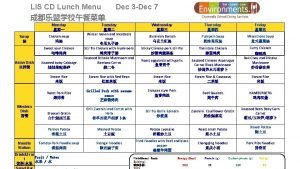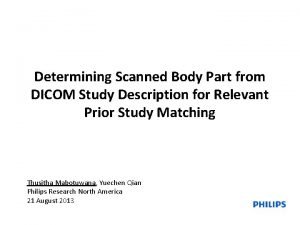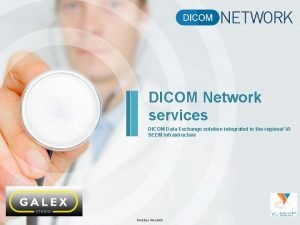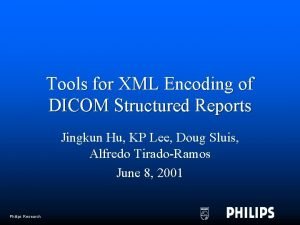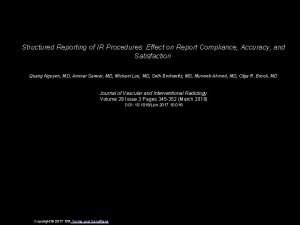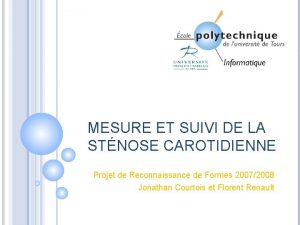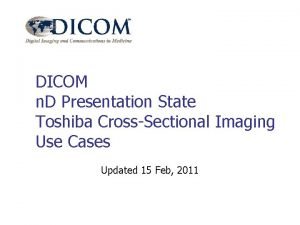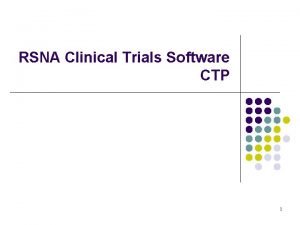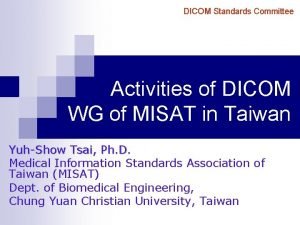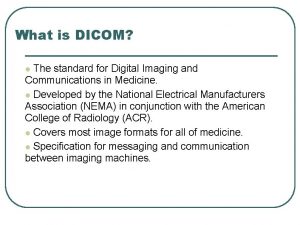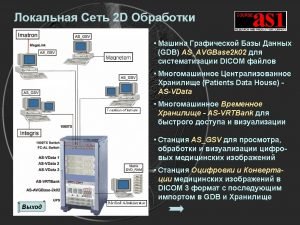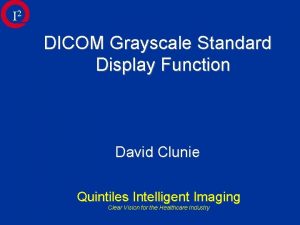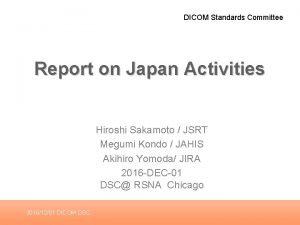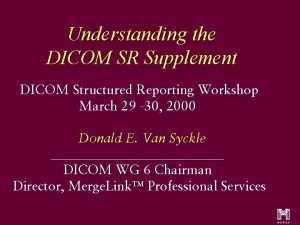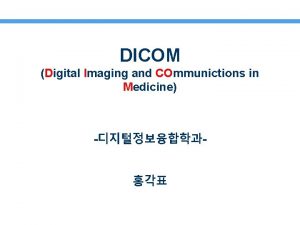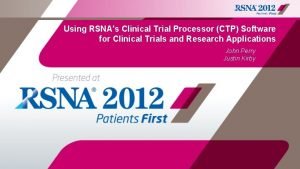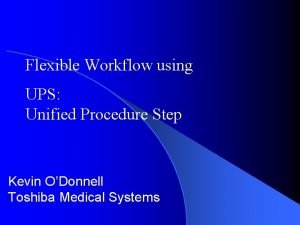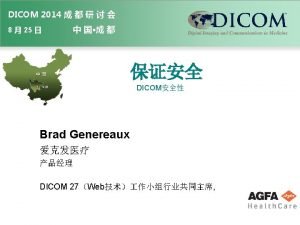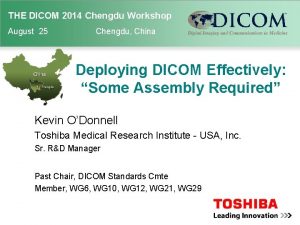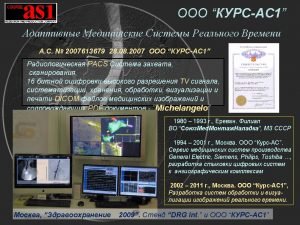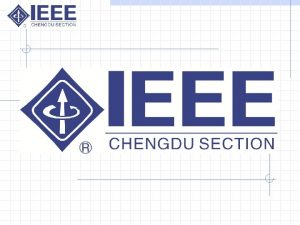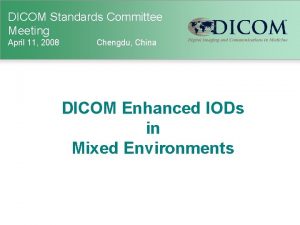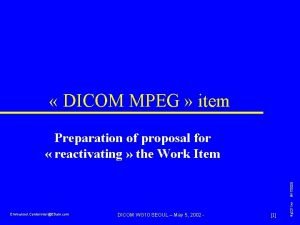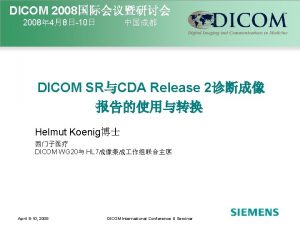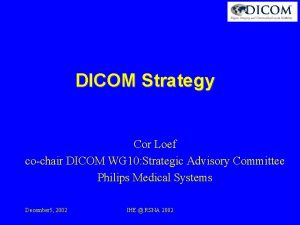THE DICOM 2014 Chengdu Workshop August 25 Chengdu






































- Slides: 38

THE DICOM 2014 Chengdu Workshop August 25 Chengdu, China Analytic Workflow: From Images to Reports Kevin O’Donnell Toshiba Medical Research Institute - USA, Inc. Sr. R&D Manager Past Chair, DICOM Standards Cmte Member, WG 6, WG 10, WG 12, WG 21, WG 29

Dataflow & Workflow Reporting Worklist Modality Performed Procedure Step (MPPS) UPS Events (Subscription) Instance Avail. Notif. Processing Worklist Processing Workstation UPS Worklist Acquisition Modality RIS Modality Worklist Reporting Workstation PACS Images 2

“Post-Acquisition” Workflow Example “Workitem” Tasks: • 3 D View Generation • Computer Aided Detection • Clinical Applications • Pre-fetching • Image Routing • CD Burning • Image Importing • … 3

Unified Procedure Step (UPS) Add “Create Workitem” & “Push Workflow” • Request another system to add item to worklist • Replacement for implicit workflow (“push to a box and hope for the best”) Simplify Implementation • GPWL had N: M relation of SPS: PPS • State diagram was very complex Add “Cancel Request” Improve Status/Result Monitoring • Getting PPS feed was awkward; required configuration and forwarding

UPS Workitem Structure UPS Object A Workitem has its attributes grouped into 4 Modules: Relationship Sched. Task Details Progress Performed Task Details (this does not affect processing; just for logical organization)

UPS Workitem Structure UPS Object Relationship Sched. Task Details Progress Performed Task Details Relationship Module - Patient demographics - Admission details - Order details - Requested Procedure - Accession # - Reason for Requested Procedure - Requesting physician/department - etc…

UPS Workitem Structure UPS Object Relationship Sched. Task Details Progress Performed Task Details Scheduled Proc. Info. Module - Priority - Requested perform/completion time - Requested resources/location - Requested Procedure descrip. /codes - Requested Processing parameters - List of Input data IDs & Location - Input Data Availability Flag - etc…

UPS Workitem Structure UPS Object Relationship Sched. Task Details Progress Performed Task Details Progress Module - UPS State (Scheduled, In-Progress, Completed, Canceled) - Progress Status – Numerical (e. g. % complete) - Progress Status – Description (e. g. Annealing phase complete) - Contact information for performer (e. g. phone #) - etc…

UPS Workitem Structure UPS Object Relationship Sched. Task Details Progress Performed Task Details Performed Proc. Info. Module - Time Performed/completed - Performing resources/location - Performed Procedure descrip. /codes - Performed Processing parameters - List of Output data IDs & Location - etc…

UPS SOP Classes A UPS Object is managed by one SCP. (It doesn’t move) UPS Object Relationship 4 SOP Classes can be used to operate on a UPS object. Each SOP Class supports a few related operations. SCU/SCP not required to implement all the SOP Classes. Can implement SOP Classes based on the operations it needs. Sched. Task Details Progress Perf. Task Details

UPS SOP Classes UPS Push SOP Class allows SCU systems to: * create (push) a new worklist item (i. e. instance) on a worklist * request cancellation of a worklist item UPS Object Relationship Sched. Task Details Progress Perf. Task Details

UPS SOP Classes UPS Pull SOP Class allows SCU systems to: * query a worklist for matching items * get details for a worklist item * take ownership/control (pull) of a worklist item * modify progress/status/result details for the worklist item * finalize a controlled worklist item as Completed or Canceled. UPS Object Relationship Sched. Task Details Progress Perf. Task Details

UPS SOP Classes UPS Watch SOP Class allows SCU systems to: * query a worklist for items of interest * subscribe/unsubscribe for change events for one worklist item * subscribe/unsubscribe for change events for all worklist items * get details for a worklist item * request cancellation of a worklist item UPS Object Relationship Sched. Task Details Progress Perf. Task Details

UPS SOP Classes UPS Object UPS Event SOP Class allows SCU systems to: * receive change events for worklist items Relationship Sched. Task Details Progress Perf. Task Details

UPS Interfaces: DIMSE and RESTful DIMSE (Traditional DICOM Protocol) • Push/Pull/Watch/Event SOP Classes RESTful (New Web Protocol) • • UPS-RS Supplement 171 (Public Comment) HTTP Interface to UPS Service Mostly Request/Response for each DIMSE message Uses Web. Sockets for Events SCP can serve DIMSE clients & RESTful clients interacting with the same UPS workitems. 15

UPS Pull Workflow Example Requester (SCU) Cre ate Sub UP Get Watcher (SCU) S UP be tate SC UP S Eve nt ont lo r bsc Su S e t Sta Query Get UPS Contents G ibe UP Dashboard System UP scri SS Worklist Manager (SCP) UPS bal nt e Ev UPS State “In-Progress” Set UPS Contents UPS State “Complete” Performer (SCU) 3 D Workstation

Pull Workflow SCP SCU 3 D Workstation RIS Give me a list of tasks that need to be done (C-FIND) UPS UPS I will do that one (N-ACTION Set to IN-PROGRESS) Record these details in the UPS (N-SET attribute values) I am finished (N-ACTION Set to COMPLETE)

Push Workflow SCP SCU RIS Please perform this task (N-CREATE with these attribute values) Notify me about progress for that task (N-ACTION Subscribe) I have started to do that task (N-EVENT it is IN-PROGRESS) I have updated details in the UPS (N-EVENT) I am finished (N-EVENT it is COMPLETE) Give me the result details of the task (N-GET these attribute values) 3 D Workstation UPS

Watch Workflow No central controller • Workstation watches flow of N-EVENTs: “System X did A”, “System Y did B” • Workstation decides “Hmmm, I think I will do C” • Workstation creates a UPS for itself • Interested Subscribers are notified of Workstation activity via N-EVENT; N-GET details as needed Similar to Ad hoc/Unscheduled Tasks Examples: • CAD workstation sees N-EVENT that Mammo Acq. is complete; decides to do CAD processing • Reporting station sees N-EVENT that CAD is complete; decides to queue reading worklist for that study

IHE Post-Acquisition Workflow IHE PAWF builds on DICOM UPS DSS / Order Filler Workitem Creator Essential Profile Features: Watcher • Worklist managed processing Workitem Manager – Automated & manual • Progress notifications – Any interested system (RIS, Billing, Reading Worklist, Dashboard, Analytics) – Subscription-based Hosting System Workitem Performer Image Manager • Cancelation requests – With reason & contact Hosted App • Hosted applications (“DICOM plugins”) 20

DICOM Application Hosting Separate the application from the infrastructure • Infrastructure (Hosting Systems) move and store data & results, and manage workflow • Applications process and analyze that data, and provide results back to the infrastructure Minimize ‘reinvention of the wheel’. (See DICOM PS 3. 19) L. Tarbox - Analytic Workflow: From Images to Reports

One App, Many Hosts Portable applications ‘plug into’ any host that implements the standardized ‘socket’ Standard API … Commercial Vendor #1 Commercial Vendor #2 Unix, Mac, PC L. Tarbox - Analytic Workflow: From Images to Reports Internet Server

Benefits of Application Hosting Users • One workstation supports any needed functionality • Mix and Match applications from multiple providers IT Administrators • Tired of changing infrastructure to accommodate new workstations simply to add functionality Application Developers • Don’t have to re-write applications for dozens of workstations in the market Workstation Vendors • Expand their list of offered applications without development effort L. Tarbox - Analytic Workflow: From Images to Reports

Perform UPS Workitems • Typical Pull Workflow – Query, Claim, Update, Complete Workitem Manager • Input / Output References Query Get Claim – Local to Performer; Local Image Manager; Other Image Manager • Hosted applications (plugins) – Performer may choose to be a Hosting System – Apps may be 3 rd party Update Complete Hosting System Workitem Performer Start App Start Task Retrieve Store Image Manager Finalize Task Hosted App 24

Create UPS Workitems • By Workitem Manager DSS / Order Filler Procedure Scheduled Procedure Updated – Internal logic – Triggered by DSS/Order Filler scheduling – Triggered by Image Manager Data • By Workitem Creator – Explicit create request – Can be grouped with any relevant system Workitem Creator Create Workitem Manager Availability Query Availability Notification Create Workitem Performer Image Manager • By Workitem Performer – Explicit create request – “Unscheduled”/Self-scheduled/Ad Hoc 25

Monitor UPS Workitems • Subscribe / Unsubscribe Query Manage Subscriptions – Globally or for Individual Workitems Watcher • Applications/Usage – – – – Schedule subsequent tasks Report progress Bill for performed tasks Populate reading worklist Drive dashboard Analyze dept. performance Claim assigned workitems Workitem Manager Created for WP 1 Send Notification… Created Claimed Progress Updated Completed Workitem Performer 26

Cancel UPS Workitems Workitem Creator • Workitem Manager – Can directly cancel unclaimed workitems – Otherwise notifies Performer • Workitem Performer – Cancels at its own discretion • Watcher Request Cancel Watcher Workitem Manager Cancel Requested Send Notification… Canceled Workitem Performer – Waits for Notification task was either Completed or Canceled 27

Applications

Scheduling Post-Processing Various co-existing patterns possible Top-down • Original order invokes full set of UPS • E. g. Protocol code -> standard processing; dept. policy Daisy chain • Each step completion triggers next UPS • Push, Pull & Watch variants Ad Hoc Performance • Performing system self-schedules own UPS • E. g. human has initiated processing Ad Hoc Request • E. g. Radiologist decides additional work-up is required; Reporting system creates UPS

Feeding into Reporting Notifications of processing tasks • Both pre-planned and ad hoc • Associate by accession # • Can monitor UPS creation and completion Processing outputs = Reporting inputs • Full set of instances is identified • Storage/retrieval location identified • Input Readiness State flag

Billing for Post-processing Billing System = Watcher • • • Notifications of processing tasks What has (actually) been performed What has been canceled When was it done Linked to patient ID & accession # Who ordered it

UPS for Reporting Workflow Possible future Profile Same worklist model as post-processing • • Scheduled tasks Relationship to Patient, Order, Workflow Lists of inputs and outputs Progress/completion notifications Linkages between post-acquisition and reporting • Less falls through cracks • Record of reported instances • New data can result in notification to radiologist or scheduling of new reporting task

References dicom. nema. org -> The DICOM Standard • Part 4, • Part 3, • Part 17, Annex CC C. 30 Annex BBB www. ihe. net -> Technical Frameworks • (Supplement) Scheduled Workflow. b • (Supplement) Post-Acquisition Workflow • and many more…

UPS Deletion Locks Reliable Watcher (SCU) • Problem: SCP might delete a completed UPS before SCU gets needed details • (e. g. due to Network latency or outage) • Missing a UPS could prevent Watcher from: • • monitoring completion extracting details creating subsequent UPS Instances, referencing UPS 1 outputs as UPS 2 inputs Mechanism § § § SCU Sets a Deletion Lock flag during subscription SCP can’t delete UPS with outstanding Deletion Locks SCU removes Deletion Lock after retrieving final state of UPS SCP free to delete UPS after all deletion locks removed SCP documents how it handles orphans

SWIM UPS are transient but can be locked/logged • • Time scheduled Time started Time completed Even intermediate progress for some tasks Track various activities • Image import, special reconstructions, automated processing, QC, image export

UPS Re-Assignment If you’ve put it In-progress • Cancel your workitem & • Create a replacement workitem (copy the details from the original) Alternatively (trickier) • Communicate the Transaction ID (“secret key”) to the system that is taking over.

UPS Profiling Use cases will drive configuration parameters • Codes for work tasks (Rad. Lex, DICOM, Site, …) • Object types to be provided as input and as output • Names of worklists managed by worklist manager Profiling = Use case driven specification of use of standards • First example is Radiotherapy, DICOM Part 17 Annex BBB

Deployment Supported in some toolkits & open source Radiotherapy • Incorporated in IHE RO Profiles • Released in Products (see IHE Integration Statements) Radiology
 Cd lunch menu
Cd lunch menu Qsi chengdu
Qsi chengdu Chengdu
Chengdu Dicom body part
Dicom body part Dicom integration solutions
Dicom integration solutions Teleradyoloji nedir
Teleradyoloji nedir Dicom structured report
Dicom structured report Dicom in dentistry
Dicom in dentistry Dicom workstation
Dicom workstation Dicom structured report
Dicom structured report Dicom gateway
Dicom gateway Suivi dicom
Suivi dicom Dicomn
Dicomn Dicompi
Dicompi Dicom standards committee
Dicom standards committee Dicom structured reporting
Dicom structured reporting C-store
C-store Agfa dicom
Agfa dicom Enhanced dicom
Enhanced dicom Dicom lookup
Dicom lookup Dicom 3
Dicom 3 Dicom monitor standard
Dicom monitor standard Dicom communication protocol
Dicom communication protocol Jira dicom
Jira dicom Dicom structured report
Dicom structured report Dicom introduction
Dicom introduction Dicom supplement 142
Dicom supplement 142 Dicom ups
Dicom ups Dicom introduction
Dicom introduction đặc điểm cơ thể của người tối cổ
đặc điểm cơ thể của người tối cổ Mật thư anh em như thể tay chân
Mật thư anh em như thể tay chân Chụp tư thế worms-breton
Chụp tư thế worms-breton ưu thế lai là gì
ưu thế lai là gì Thẻ vin
Thẻ vin Bàn tay mà dây bẩn
Bàn tay mà dây bẩn Các châu lục và đại dương trên thế giới
Các châu lục và đại dương trên thế giới Bổ thể
Bổ thể Từ ngữ thể hiện lòng nhân hậu
Từ ngữ thể hiện lòng nhân hậu Diễn thế sinh thái là
Diễn thế sinh thái là
